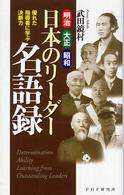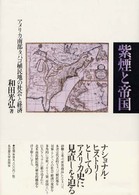- ホーム
- > 洋書
- > 英文書
- > Folklore / Mythology
Full Description
Fairies might be good or bad, and encounters with them funny or fatal. They can take on the form of people or animals, or they may have no form at all, as when a person walking in the woods is "led astray" by some irresistible force. This variability in fairies is matched by the diversity of human attitudes about them.
Barbara Rieti's study began in 1983 when she met a young man who told her that he had been followed by the fairies. Subsequent research drew on the hundreds of archival accounts of fairies and on Dr. Rieti's own fieldwork on Newfoundland's Avalon Peninsula. Rieti describes the specific contexts in which fairy experiences are recounted and the manner in which they are told, keeping the storytellers at centre stage. She also highlights themes such as connections between fairies and nature, and the relationships between fairies and people. Comparative material sets the subject in historical and international context and demonstrates the remarkable tenacity of these old yet persistent tales.
The fairies may be going, but they are not gone yet. The stories still to be heard offer a window on everyday folklife, as well as on an extraordinary world.
Contents
Foreword by Diane Tye (ix)
Epigraph (xvi)
Preface to the Second Edition (xvii)
Preface to the First Edition (xxv)
Acknowledgements (xxvii)
A Note on the Documentation and Transcription of Sources (xxx)
Always Going and Never Gone? (1)
Fairy Forms and Narrative Contexts: An Overview (17)
Bread, Wind, Old Paths: The Texture and Planes of Everyday Life in Fairy Narrative (65)
Tradition and the Interpretation of Experience (109)
Fairies, Devils, and Other Impostors in Bishop's Cove: Tales of a Trickster (153)
UFOs: Urban Fairy Oddities, and Some Modern Influences on the Genesis and Evolution of Fairy Tradition (189)
Fairy Tradition as Discourse on Time and Change (227)
Conclusion (265)
Notes (271)
Bibliography (309)
Informant Index (337)








